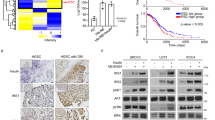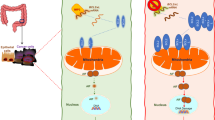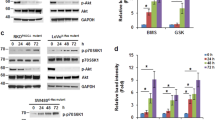Abstract
Insulin receptor (IR) and the type I IGF receptor (IGF1R) are structurally and functionally related. The function of IGF1R in cancer has been well documented and anti-IGF1R strategies to treat cancer have shown initial positive results. However, the role of IR in tumor biology, independent of IGF1R, is less clear. To address this issue, short hairpin RNA (shRNA) was used to specifically downregulate IR in two cancer cell lines, LCC6 and T47D. Cells with reduced IR showed reduced insulin-stimulated Akt activation, without affecting IGF1R activation. Cells with reduced IR formed fewer colonies in anchorage-independent conditions. LCC6 IR shRNA xenograft tumors in mice had reduced growth, angiogenesis and lymphangiogensis when compared with LCC6 wild-type cells. Accordingly, LCC6 IR shRNA clones produced less hypoxia-inducible factor-1α, vascular endothelial growth factor (VEGF)-A and VEGF-D. Furthermore, LCC6 IR shRNA cells formed fewer pulmonary metastases when compared with LCC6 wild-type cells. Using in vivo luciferase imaging, we have shown that LCC6 IR shRNA cells have less seeding and colonization potential in the lung and liver of mice than LCC6 cells. In conclusion, downregulation of IR inhibited cancer cell proliferation, angiogenesis, lymphangiogenesis and metastasis. Our data argue that IR should also be targeted in cancer therapy.
This is a preview of subscription content, access via your institution
Access options
Subscribe to this journal
Receive 50 print issues and online access
$259.00 per year
only $5.18 per issue
Buy this article
- Purchase on Springer Link
- Instant access to full article PDF
Prices may be subject to local taxes which are calculated during checkout








Similar content being viewed by others
References
Ademuyiwa FO, Miller KD . (2008). Incorporation of antiangiogenic therapies in the treatment of metastatic breast cancer. Clin Breast Cancer 8 (Suppl 4): S151–S156.
Avnet S, Sciacca L, Salerno M, Gancitano G, Cassarino MF, Longhi A et al. (2009). Insulin receptor isoform A and insulin-like growth factor II as additional treatment targets in human osteosarcoma. Cancer Res 69: 2443–2452.
Bjorndahl M, Cao R, Nissen LJ, Clasper S, Johnson LA, Xue Y et al. (2005). Insulin-like growth factors 1 and 2 induce lymphangiogenesis in vivo. Proc Natl Acad Sci USA 102: 15593–15598.
Byron SA, Horwitz KB, Richer JK, Lange CA, Zhang X, Yee D . (2006). Insulin receptor substrates mediate distinct biological responses to insulin-like growth factor receptor activation in breast cancer cells. Br J Cancer 95: 1220–1228.
Chambers AF . (2009). MDA-MB-435 and M14 cell lines: identical but not M14 melanoma? Cancer Res 69: 5292–5293.
Dillon RL, Marcotte R, Hennessy BT, Woodgett JR, Mills GB, Muller WJ . (2009). Akt1 and akt2 play distinct roles in the initiation and metastatic phases of mammary tumor progression. Cancer Res 69: 5057–5064.
Dunn SE, Ehrlich M, Sharp NJ, Reiss K, Solomon G, Hawkins R et al. (1998). A dominant negative mutant of the insulin-like growth factor-I receptor inhibits the adhesion, invasion, and metastasis of breast cancer. Cancer Res 58: 3353–3361.
Eccles S, Paon L, Sleeman J . (2007). Lymphatic metastasis in breast cancer: importance and new insights into cellular and molecular mechanisms. Clin Exp Metastasis 24: 619–636.
Feldser D, Agani F, Iyer NV, Pak B, Ferreira G, Semenza GL . (1999). Reciprocal positive regulation of hypoxia-inducible factor 1alpha and insulin-like growth factor 2. Cancer Res 59: 3915–3918.
Frasca F, Pandini G, Scalia P, Sciacca L, Mineo R, Costantino A et al. (1999). Insulin receptor isoform A, a newly recognized, high-affinity insulin-like growth factor II receptor in fetal and cancer cells. Mol Cell Biol 19: 3278–3288.
Frasca F, Pandini G, Sciacca L, Pezzino V, Squatrito S, Belfiore A et al. (2008). The role of insulin receptors and IGF-I receptors in cancer and other diseases. Arch Physiol Biochem 114: 23–37.
Frasca F, Pandini G, Vigneri R, Goldfine ID . (2003). Insulin and hybrid insulin/IGF receptors are major regulators of breast cancer cells. Breast Dis 17: 73–89.
Fukuda R, Hirota K, Fan F, Jung YD, Ellis LM, Semenza GL . (2002). Insulin-like growth factor 1 induces hypoxia-inducible factor 1-mediated vascular endothelial growth factor expression, which is dependent on MAP kinase and phosphatidylinositol 3-kinase signaling in colon cancer cells. J Biol Chem 277: 38205–38211.
Goodwin PJ, Ennis M, Pritchard KI, Trudeau ME, Koo J, Madarnas Y et al. (2002). Fasting insulin and outcome in early-stage breast cancer: results of a prospective cohort study. J Clin Oncol 20: 42–51.
Haluska P, Carboni JM, Loegering DA, Lee FY, Wittman M, Saulnier MG et al. (2006). In vitro and in vivo antitumor effects of the dual insulin-like growth factor-I/insulin receptor inhibitor, BMS-554417. Cancer Res 66: 362–371.
Heuson JC, Legros N . (1972). Influence of insulin deprivation on growth of the 7,12-dimethylbenz(a)anthracene-induced mammary carcinoma in rats subjected to alloxan diabetes and food restriction. Cancer Res 32: 226–232.
Hewish M, Chau I, Cunningham D . (2009). Insulin-like growth factor 1 receptor targeted therapeutics: novel compounds and novel treatment strategies for cancer medicine. Recent Pat Anticancer Drug Discov 4: 54–72.
Ji QS, Mulvihill MJ, Rosenfeld-Franklin M, Cooke A, Feng L, Mak G et al. (2007). A novel, potent, and selective insulin-like growth factor-I receptor kinase inhibitor blocks insulin-like growth factor-I receptor signaling in vitro and inhibits insulin-like growth factor-I receptor dependent tumor growth in vivo. Mol Cancer Ther 6: 2158–2167.
Karey KP, Sirbasku DA . (1988). Differential responsiveness of human breast cancer cell lines MCF-7 and T47D to growth factors and 17 beta-estradiol. Cancer Res 48: 4083–4092.
Kasuya J, Paz IB, Maddux BA, Goldfine ID, Hefta SA, Fujita-Yamaguchi Y . (1993). Characterization of human placental insulin-like growth factor-I/insulin hybrid receptors by protein microsequencing and purification. Biochemistry 32: 13531–13536.
Leonessa F, Green D, Licht T, Wright A, Wingate-Legette K, Lippman J et al. (1996). MDA435/LCC6 and MDA435/LCC6MDR1: ascites models of human breast cancer. Br J Cancer 73: 154–161.
Li J, Bosch-Marce M, Nanayakkara A, Savransky V, Fried SK, Semenza GL et al. (2006). Altered metabolic responses to intermittent hypoxia in mice with partial deficiency of hypoxia-inducible factor-1alpha. Physiol Genomics 25: 450–457.
Ma J, Li H, Giovannucci E, Mucci L, Qiu W, Nguyen PL et al. (2008). Prediagnostic body-mass index, plasma C-peptide concentration, and prostate cancer-specific mortality in men with prostate cancer: a long-term survival analysis. Lancet Oncol 9: 1039–1047.
Maira SM, Stauffer F, Brueggen J, Furet P, Schnell C, Fritsch C et al. (2008). Identification and characterization of NVP-BEZ235, a new orally available dual phosphatidylinositol 3-kinase/mammalian target of rapamycin inhibitor with potent in vivo antitumor activity. Mol Cancer Ther 7: 1851–1863.
Nandi S, Guzman RC, Yang J . (1995). Hormones and mammary carcinogenesis in mice, rats, and humans: a unifying hypothesis. Proc Natl Acad Sci USA 92: 3650–3657.
Novosyadlyy R, Vijayakumar A, Lann D, Fierz Y, Kurshan N, LeRoith D . (2009). Physical and functional interaction between polyoma virus middle T antigen and insulin and IGF-I receptors is required for oncogene activation and tumour initiation. Oncogene 28: 3477–3486.
Osborne CK, Bolan G, Monaco ME, Lippman ME . (1976). Hormone responsive human breast cancer in long-term tissue culture: effect of insulin. Proc Natl Acad Sci USA 73: 4536–4540.
Pandini G, Vigneri R, Costantino A, Frasca F, Ippolito A, Fujita-Yamaguchi Y et al. (1999). Insulin and insulin-like growth factor-I (IGF-I) receptor overexpression in breast cancers leads to insulin/IGF-I hybrid receptor overexpression: evidence for a second mechanism of IGF-I signaling. Clin Cancer Res 5: 1935–1944.
Pollak M . (2008). Insulin and insulin-like growth factor signalling in neoplasia. Nat Rev Cancer 8: 915–928.
Price JE . (1996). Metastasis from human breast cancer cell lines. Breast Cancer Res Treat 39: 93–102.
Rae JM, Creighton CJ, Meck JM, Haddad BR, Johnson MD . (2007). MDA-MB-435 cells are derived from M14 melanoma cells--a loss for breast cancer, but a boon for melanoma research. Breast Cancer Res Treat 104: 13–19.
Sachdev D, Hartell JS, Lee AV, Zhang X, Yee D . (2004). A dominant negative type I insulin-like growth factor receptor inhibits metastasis of human cancer cells. J Biol Chem 279: 5017–5024.
Sachdev D, Li SL, Hartell JS, Fujita-Yamaguchi Y, Miller JS, Yee D . (2003). A chimeric humanized single-chain antibody against the type I insulin-like growth factor (IGF) receptor renders breast cancer cells refractory to the mitogenic effects of IGF-I. Cancer Res 63: 627–635.
Sachdev D, Yee D . (2001). The IGF system and breast cancer. Endocr Relat Cancer 8: 197–209.
Sachdev D, Yee D . (2006). Inhibitors of insulin-like growth factor signaling: a therapeutic approach for breast cancer. J Mammary Gland Biol Neoplasia 11: 27–39.
Stoeltzing O, Liu W, Reinmuth N, Fan F, Parikh AA, Bucana CD et al. (2003). Regulation of hypoxia-inducible factor-1alpha, vascular endothelial growth factor, and angiogenesis by an insulin-like growth factor-I receptor autocrine loop in human pancreatic cancer. Am J Pathol 163: 1001–1011.
Tang Y, Zhang D, Fallavollita L, Brodt P . (2003). Vascular endothelial growth factor C expression and lymph node metastasis are regulated by the type I insulin-like growth factor receptor. Cancer Res 63: 1166–1171.
Treins C, Giorgetti-Peraldi S, Murdaca J, Semenza GL, Van Obberghen E . (2002). Insulin stimulates hypoxia-inducible factor 1 through a phosphatidylinositol 3-kinase/target of rapamycin-dependent signaling pathway. J Biol Chem 277: 27975–27981.
Vander Heiden MG, Cantley LC, Thompson CB . (2009). Understanding the Warburg effect: the metabolic requirements of cell proliferation. Science 324: 1029–1033.
Wang JQ, Pollok KE, Cai S, Stantz KM, Hutchins GD, Zheng QH . (2006). PET imaging and optical imaging with D-luciferin [11C]methyl ester and D-luciferin [11C]methyl ether of luciferase gene expression in tumor xenografts of living mice. Bioorg Med Chem Lett 16: 331–337.
Weroha SJ, Haluska P . (2008). IGF-1 receptor inhibitors in clinical trials—early lessons. J Mammary Gland Biol Neoplasia 13: 471–483.
Zhang H, Pelzer AM, Kiang DT, Yee D . (2007). Down-regulation of type I insulin-like growth factor receptor increases sensitivity of breast cancer cells to insulin. Cancer Res 67: 391–397.
Zhang H, Yee D . (2006). Is the type I insulin-like growth factor receptor a therapeutic target in endometrial cancer? Clin Cancer Res 12: 6323–6325.
Acknowledgements
We are grateful to Colleen Forster for the technical service on immunohistochemistry staining of tumor and lung tissue. We thank Dr Ilze Matise from the Masonic Cancer Center Comparative Pathology Shared Resource for valuable advice. We thank Dr Yunfang Li and Dr Kalpna Gupta from Masonic Cancer Center for detailed protocol of LYVE-1 and CD31 staining in tumor samples. We appreciate Dr Minghai Shao and Dr Daniela E Matei from Indiana University School of Medicine for providing the retroviral vector expressing luciferase. We acknowledge the assistance of the Flow Cytometry Core Shared Resource of the Masonic Cancer Center. Animal imaging was performed at the Biomedical Image Processing laboratory at University of Minnesota. This work was supported by Department of Defense Breast Cancer Research Program post-doctoral Grant BC050548 to HZ, National Institutes of Health R01CA74285 to DY and National Cancer Institute Cancer Center Support Grant P30 077598.
Author information
Authors and Affiliations
Corresponding author
Ethics declarations
Competing interests
The authors declare no conflict of interest.
Additional information
Supplementary Information accompanies the paper on the Oncogene website
Supplementary information
Rights and permissions
About this article
Cite this article
Zhang, H., Fagan, D., Zeng, X. et al. Inhibition of cancer cell proliferation and metastasis by insulin receptor downregulation. Oncogene 29, 2517–2527 (2010). https://doi.org/10.1038/onc.2010.17
Received:
Revised:
Accepted:
Published:
Issue Date:
DOI: https://doi.org/10.1038/onc.2010.17



